How to Make Coconut Flour – 3 Easy Ways
Looking for a low carb and grain free flour for cooking and baking? Try homemade coconut flour. Learn how to make coconut flour with this simple recipe, and discover tips for making delicious and healthy recipes. Coconut flour is low carb, gluten free, grain free, AIP, Paleo and Keto friendly.
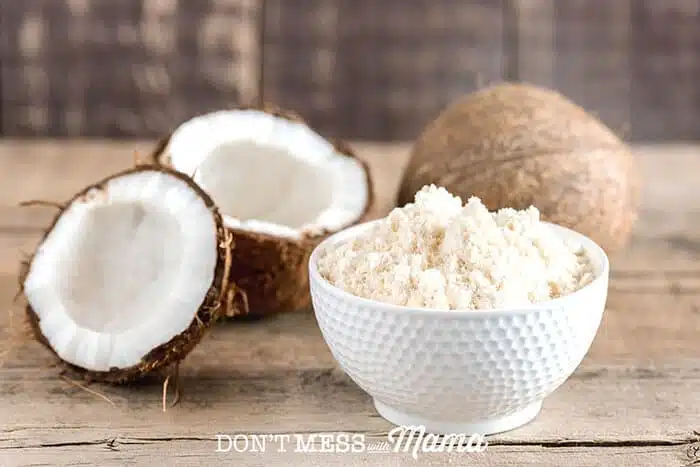
This post contains affiliate links. Please read my affiliate disclosure.
Are you looking for a low-carb option to traditional wheat flour and gluten-free flour? Coconut flour is a great option, and it’s so easy to make. It’s perfect for gluten-free, grain-free low carb, Paleo and Keto diets.
What is coconut flour?
Coconut flour is made from coconut solid, or the “meat” of the coconut. When you crack open a coconut, you’ll see the coconut meat and the coconut water. The coconut meat can be used fresh or dried (also known as coconut flakes) to make coconut flour.
Coconut flour is often made from the leftover pulp from making homemade coconut milk (with fresh coconut meat or dried coconut flakes). Check out my tutorial and recipe to make fresh your own coconut milk. The downside to this is much of the fat and from the coconut meat is in the milk rather than pulp itself so it can taste drier compared to coconut flour made from flakes or coconut meat. You can dehydrate the coconut meat or use dried coconut flakes to make coconut flour with the fat to avoid this. Either option is great for cooking and baking.
Coconut flour is popular for gluten free, grain free, Keto, Paleo and low-carb recipes, since it is low in carbohydrates and high in fiber. It does have a mild coconut flavor, and can be used in baking, cooking, frying, and much more. It’s great for both sweet and savory dishes.
Benefits of coconut flour
Let’s look at the nutritional profile of coconut flour. Compared to traditional wheat flour and grain-based flours, coconut flour has more protein, fat, and fiber yet it’s considered a low-carb flour. It’s ideal for those on a low-carb diet, Paleo diet, keto diet, GAPS, low glycemic index, grain-free, gluten-free and SCD diets. In addition, it’s a low-carb alternative to almond flour and other nut flours that may be an issue for those with nut allergies.
What’s in 2 tablespoons of coconut flour:
- 60 calories
- 1.5 grams fat (no trans fat)
- 9 grams carbohydrates
- 5 grams dietary fiber
- 3 grams protein
- 1 mg iron
Why choose coconut flour:
- High in fiber – contains about 8% daily value of dietary fiber, which helps you to stay regular in the bathroom
- Curbs cravings – because it’s high in fiber you’ll stay fuller for longer to help curb those hunger cravings
- Low carb – about 9 grams of carbohydrates but 5 of those grams are dietary fiber, which means it has 4 net carbs and makes it low carb compared to other flours
- Good source of protein – it’s comparable to wheat flour in protein but with much less carbs
- Good source of iron – about 1 mg (6% of daily value), which is good for those who need more iron like vegans or vegetarians
- Good source of potassium – about 280 mg (6% of daily value)
How do you make coconut flour?
It’s really easy to make your own coconut flour. First, you need the coconut meat. You can get this from fresh coconuts or dried coconut flakes. There’s a few methods depending on what you want.
1. Coconut Pulp Method (After Making Coconut Milk)
You’ll get a 2 for 1 benefit with this method – both coconut milk and coconut flour. You’ll need to extract the coconut milk first, and then use what’s leftover to make coconut flour. Here’s how to make your own batch of coconut milk. After you make the coconut milk, you sift out the leftover coconut pulp with a nut milk bag or cheesecloth to make coconut flour. Remember, this might be a bit drier than the other two methods.
- Pre-heat oven to 120°F (50°C) or the lowest temperature.
- Line a baking sheet with parchment paper.
- Spread out 2 cups dried coconut pulp on parchment paper and bake for 45 minutes or until the pulp is dried (no moisture at all).
- Remove from oven and let cool for a few minutes
- Blend coconut pulp in a Vitamix or food processor for 1-2 minutes until pulp becomes a fine powder.
2. Fresh Coconut Method
- Pre-heat oven to 120°F (50°C) or the lowest temperature.
- Line a large baking tray with parchment paper.
- Crack a fresh coconut and pour out the water to save to drink later.
- Peel the brown outer layer so all you have is the white part – the coconut meat.
- Cut the white coconut meat into chunks and either grate it or pulse in a food processor to make it into a crumbly texture. Be careful not to pulse too long, or you’ll end up with coconut milk. If so, use the #1 method mentioned above.
- Spread the grated coconut on parchment paper and bake for 45 minutes or until the pulp is dried (no moisture at all).
- Remove from oven and let cool for a few minutes
- Blend coconut pulp in a Vitamix or food processor for 1-2 minutes until pulp becomes a fine powder.
3. Coconut Flakes Method
This might be the easiest method of all three and you’ve still got the full fat in the shredded coconut flakes.
- Add 1 cup of dried unsweetened coconut flakes to a high-speed blender or food processor.
- Blend until it’s a flour-like consistency, about 3-4 minutes.
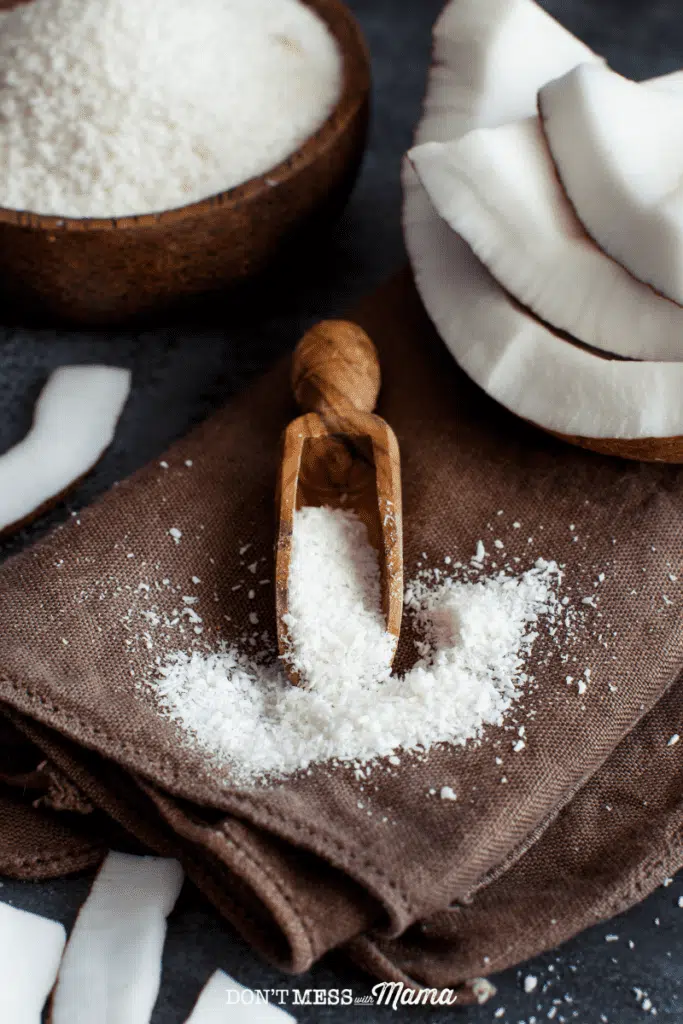
Storage Tips
Store coconut flour in an air-tight sealed container. Be sure it’s fully dried before storage. You can store it in a cool, dry place like pantry or freezer. Coconut flour can last up to a year if you store it in a cool, dry place like the pantry or even in the freezer.
How to Use Coconut Flour
You can use coconut flour in a variety of sweet and savory recipes. Here are 100+ best coconut flour recipes you might enjoy. Typically, you will use less coconut flour and a lot of liquid in recipes, as coconut flour is drier and more dense.
Can I substitute coconut flour for regular flour?
Yes, but not in a 1:1 to ratio. Coconut flour is very dense and dry compared to all-purpose wheat flour and even gluten-free flour.
For baking, generally you will use about 1/4 of the amount of flour and more eggs or liquid. Coconut flour is very absorbent, so you’ll need more liquid than a recipe that call for regular wheat or gluten-free flour. It would be best to use a recipe that specifically calls for coconut flour, rather than a adapt your favorite recipe that calls for traditional flour to get the right consistency. As a general rule, if you’re using 2 tbsp of coconut flour, you’ll want to add about 2 tbsp of liquid so your baked goods don’t come out dry.
For frying, generally you can use coconut flour as it gives food a crunchy texture that’s delicious. You may need to combine it with another type of flour (like tapioca, potato, almond, or your favorite gluten-free flour blend) to get the right consistency.
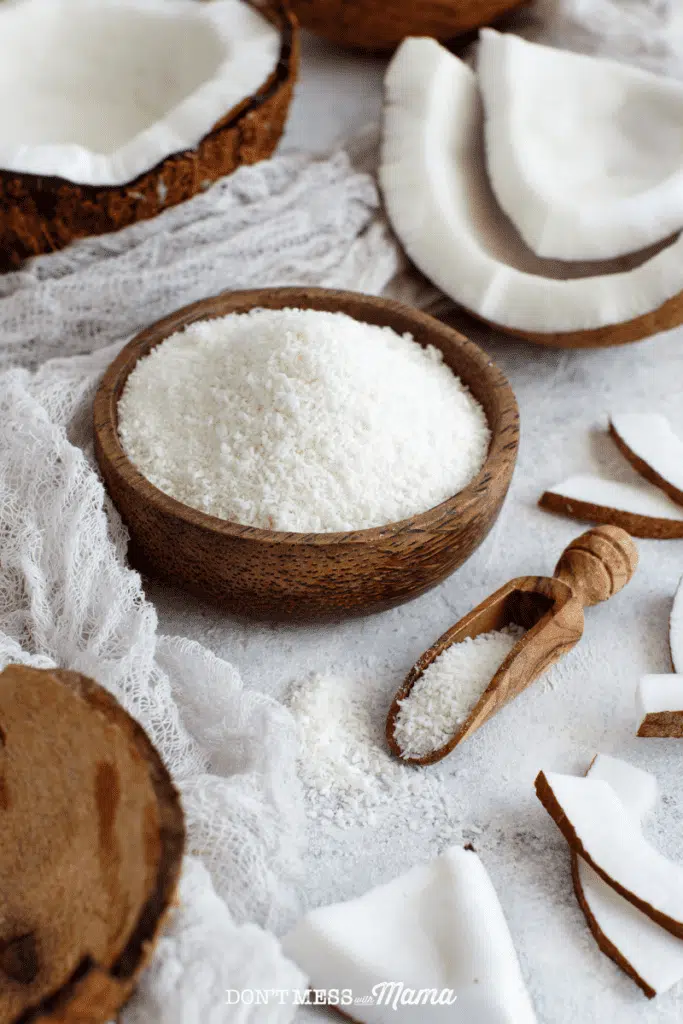
Why do I need to use eggs with coconut flour?
Coconut flour is very absorbent, and a very small amount of flour will absorb a very large amount of liquid. It also tends to have a drying effect on baked goods, because it is so absorbent. The best way to counteract its drying effect is to use plenty of eggs when you’re baking. The protein in egg whites helps to provide structure (binds the ingredients) to baked goods while the yolks provide moisture.
Additionally, it’s a good practice to separate your eggs, beating the flour with egg yolks and then beating the whites separately until they hold stiff peaks. You can then fold the whites into the egg yolk and flour mixture, and this improves the natural heaviness of many baked goods that use coconut flour as an ingredient.
If you’re looking for an egg substitute, try ground flaxseed or chia seeds and water. Here’s a general guideline:
- Chia or flax seeds – Mix 1 tbsp ground chia seeds or ground flax seeds with 3 tbsp of hot water. Let sit for 5 minutes. Makes enough to replace 1 egg
- Psyllium husk – Mix 1 tsp psyllium husk with 2 tbsp of water for 1 egg
- Vegan egg replacer – Use Ener-G egg replacer. 1 1/2 tsp of Ener-G mixed with 2 tbsp of warm water for 1 egg
- Arrowroot powder – Mix 2 tbsp arrowroot powder with 3 tbsp water to replace 1 egg
Do I need to sift coconut flour?
Foods baked with coconut flour can often have a gritty texture, so it’s best to sift the flour thoroughly before you bake with it.
Does coconut flour have a strong coconut flavor?
Coconut flour does have a mild coconut scent ,and will infuse a coconut flavor to baked goods, especially baked goods that don’t include any other strongly flavored ingredients, such as spices or cocoa powder. This can be a bonus for coconut fans, but might be a negative for people who don’t particularly like the flavor of coconut.
Top Tips for Making Coconut Flour
- Sift well before using
- If making milk from coconuts, use leftover pulp to make coconut flour.
- Use a preheated oven.
- Store in an airtight container.
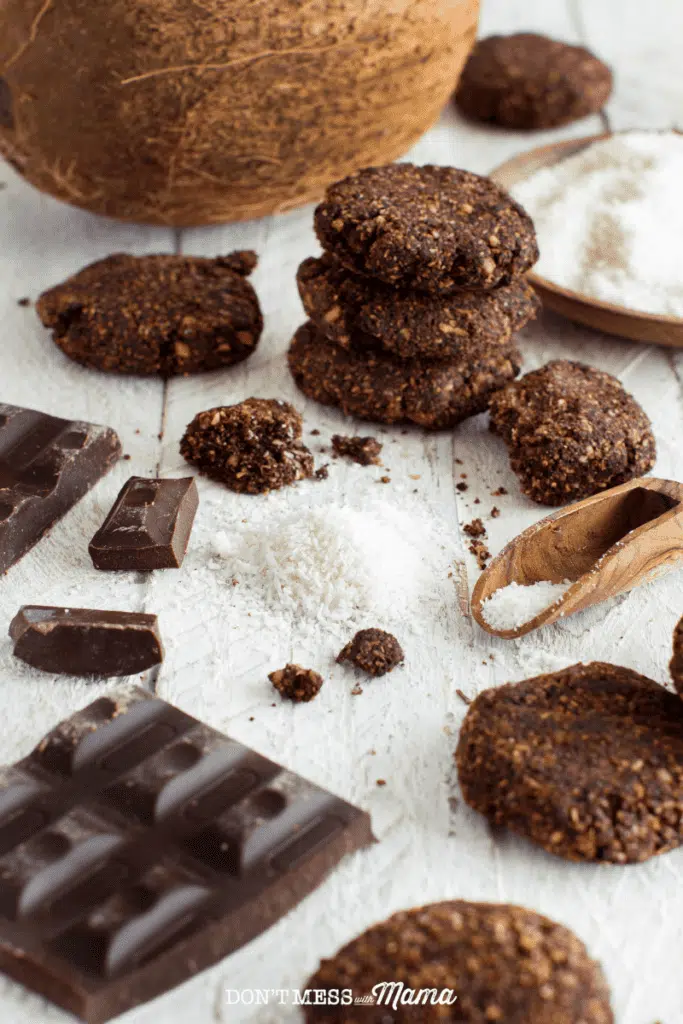
More Recipes You Might Like
Did you try this? Don’t forget to rate it and comment below to let me know how it went. You can also FOLLOW ME on Facebook, Instagram and Pinterest.

How to Make Coconut Flour
Equipment
- Vitamix
- Baking sheet
- Parchment paper
Ingredients
- 2 cups coconut pulp leftover from making coconut milk
- air-tight container
Instructions
- Heat oven to 120°F (50°C).
- Line a baking sheet with parchment paper.
- Spread out coconut pulp on parchment paper and bake for 45 minutes or until the coconut pulp is dried (no moisture at all).
- Remove from oven and let cool for a few minutes
- Blend coconut pulp in a Vitamix or food processor for 1-2 minutes until pulp becomes a fine powder.
- Store coconut flour in an air-tight container.
Notes
- Pre-heat oven to 120°F (50°C) or the lowest temperature.
- Line a large baking tray with parchment paper.
- Crack a fresh coconut and pour out the water to save to drink later.
- Peel the brown outer layer so all you have is the white part – the coconut meat.
- Cut the white coconut meat into chunks and either grate it or pulse in a food processor to make it into a crumbly texture. Be careful not to pulse too long, or you’ll end up with coconut milk. If so, use the #1 method mentioned above.
- Spread the grated coconut on parchment paper and bake for 45 minutes or until the pulp is dried (no moisture at all).
- Remove from oven and let cool for a few minutes
- Blend coconut pulp in a Vitamix or food processor for 1-2 minutes until pulp becomes a fine powder.
- Add 1 cup of dried unsweetened coconut flakes to a high-speed blender or food processor.
- Blend until it’s a flour-like consistency, about 3-4 minutes.
Nutrition
Want More Recipes?
Check out my new book, Gluten-Free, Real Food Recipes for Kids.
I wrote this book with YOU in mind. Parents who want to provide kids with wholesome meals without artificial colors, preservatives and other additives.
All the recipes are gluten-free – with many options for grain free or Paleo, dairy free, egg free and vegetarian.
What’s Included In This Book
It’s filled with 130+ pages of content and recipes, including:
- Real food nutrition 101
- Detailed information on how to properly soak and sprout nuts, beans, grains and seeds
- A guide on how to spot chemical additives and what to avoid
- Kitchen essentials and cooking tools
- Tips on how to get kids to become better eaters and help in the kitchen
- 70+ gluten-free recipes – such as snacks and appetizers, beverages, condiments and dressings, main meals, desserts and more
Take a peek what’s inside Gluten-Free, Real Food Recipes for Kids.
Sources:
https://fdc.nal.usda.gov/fdc-app.html#/food-details/583168/nutrients
https://www.healthline.com/nutrition/egg-substitutes
Photo credit: Bigstockphoto.com / katekrsk

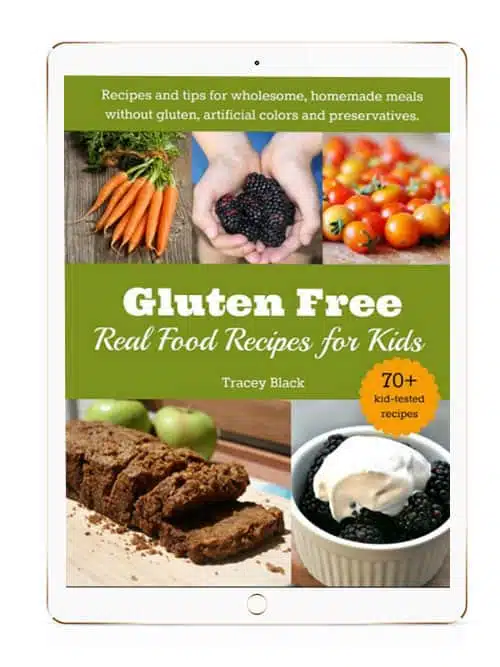
I like that you said to dry the flour at 120°F for 45 minutes. That was helpful my recipe was the same as yours but didn’t specify how long to dry or at what temperature.
thanks! nice work!!
My oven only goes to 170 degrees Fahrenheit. Any suggestions on how to dry at that temp?
I had no clue how easy it was to make coconut flour, can’t wait to try it!